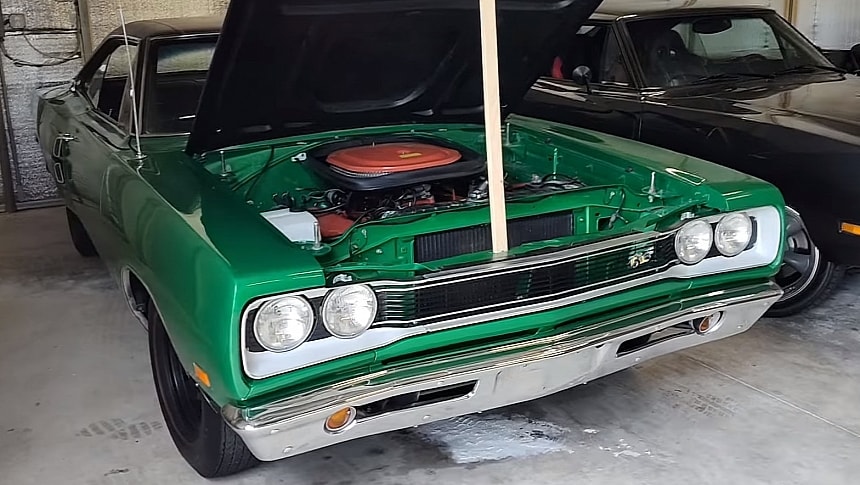In 1968, Dodge transformed the fancy fastback Charger into a more traditional muscle car. That same year also saw the arrival of the Super Bee as the company's entry-level muscle car. Plymouth did the same thing with the Road Runner, which slotted under the more luxurious GTX.
Restricted to two-door body styles and big-block V8 engines, the Super Bee found only 7,842 customers in the shortened 1968 model year. Sales then jumped to 27,800 units in 1969 before dropping to 15,506 examples in 1970. Although it wasn't a flop sales-wise, the Super Bee sold poorly compared to the Road Runner, which moved more than 160,000 units from 1968 to 1970.
More than 50 years have passed since then, and the Super Bee is obviously the scarcest of the two. Rarity also makes it more desirable, especially if we're talking about cars fitted with the range-topping 426-cubic-inch (7.0-liter) HEMI or the 440-cubic-inch (7.2-liter) Six-Pack units.
The HEMI is the holy grail of the Super Bee family, with only 349 units produced from 1968 to 1971. The Six-Pack cars aren't exactly common either. Introduced in 1969, the beefed-up engine found its way in only 3,274 vehicles through 1971. But on top of being rare, these Super Bees are also significantly more expensive than their entry-level, 383-cubic-inch (6.3-liter) counterparts. And not surprisingly, some 383 cars have been transformed into HEMI or A12 (Six-Pack) tributes. The green hardtop you see here is one of those cars.
Born with a 383 big-block V8 and an automatic transmission, this Super Bee now packs a 440 Six-Pack and four-speed manual gearbox. This combo is the second most desirable from the golden muscle car era after the HEMI four-speed. Both the engine and the transmission were reportedly sourced together from a true-blue Six-Pack, but there's no word whether the donor was a Super Bee or a different Mopar.
Whoever made the swap also dropped an authentic Six-Pack hood atop the engine bay, so this tribute car also looks correct on the outside. A pistol-grip shifter and a Dana 4.10 rear end round off the package.
The owner also went with a color change. Now finished in Rallye Green, the hardtop was originally painted B5 Blue. Both colors are fetching, but Rallye Green is a slightly better choice in my book. It's also a tad more desirable.
Visually, the car is pretty much spotless. Cleaning is needed to remove all that storage dust, but this Mopar is very close to Concours condition. That's a task for the next owner because the Super Bee is for sale. The Rally Green hardtop is wearing a $79,995 sticker, which is about $30K below a fully-fledged A12 Six-Pack in similar condition (1,907 units made regardless of the gearbox). Is that a fair price for a clone?
More than 50 years have passed since then, and the Super Bee is obviously the scarcest of the two. Rarity also makes it more desirable, especially if we're talking about cars fitted with the range-topping 426-cubic-inch (7.0-liter) HEMI or the 440-cubic-inch (7.2-liter) Six-Pack units.
The HEMI is the holy grail of the Super Bee family, with only 349 units produced from 1968 to 1971. The Six-Pack cars aren't exactly common either. Introduced in 1969, the beefed-up engine found its way in only 3,274 vehicles through 1971. But on top of being rare, these Super Bees are also significantly more expensive than their entry-level, 383-cubic-inch (6.3-liter) counterparts. And not surprisingly, some 383 cars have been transformed into HEMI or A12 (Six-Pack) tributes. The green hardtop you see here is one of those cars.
Born with a 383 big-block V8 and an automatic transmission, this Super Bee now packs a 440 Six-Pack and four-speed manual gearbox. This combo is the second most desirable from the golden muscle car era after the HEMI four-speed. Both the engine and the transmission were reportedly sourced together from a true-blue Six-Pack, but there's no word whether the donor was a Super Bee or a different Mopar.
Whoever made the swap also dropped an authentic Six-Pack hood atop the engine bay, so this tribute car also looks correct on the outside. A pistol-grip shifter and a Dana 4.10 rear end round off the package.
The owner also went with a color change. Now finished in Rallye Green, the hardtop was originally painted B5 Blue. Both colors are fetching, but Rallye Green is a slightly better choice in my book. It's also a tad more desirable.
Visually, the car is pretty much spotless. Cleaning is needed to remove all that storage dust, but this Mopar is very close to Concours condition. That's a task for the next owner because the Super Bee is for sale. The Rally Green hardtop is wearing a $79,995 sticker, which is about $30K below a fully-fledged A12 Six-Pack in similar condition (1,907 units made regardless of the gearbox). Is that a fair price for a clone?











